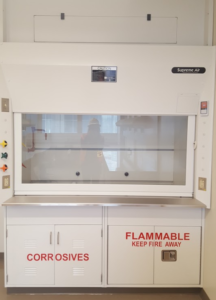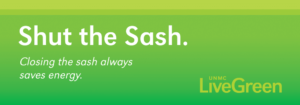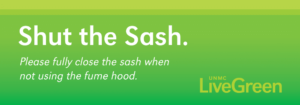Shut the Sash

Shutting the sash ensures safety and conserves energy
A fume hood sash is a see-through panel that moves up and down to allow access into the fume hood. Air is being pulled from the lab into the fume hood and out of the building in order to keep noxious fumes out of labs and ensure researchers’ safety. Although fume hoods are very important for the lab, they use A LOT of energy.
Shutting the fume hood sash when not in use:
- Saves the amount of energy that 3.5 homes use each day.
- Ensures safety of lab users.
- Saves the university $700,000 to $900,000 annually by ensuring the air exchange system runs efficiently. (This is nearly a third of the energy that the two Durham research towers currently consume!)
- Limits the amount of conditioned air that exits the building.
- Allows fans to operate at lower speeds, reducing the amount of energy needed.
- Prevents alarms from being triggered.
- Helps the university achieve their 2030 sustainability goals.
How you can help
- Shut the sash each time you walk away and remind your lab-mates to as well!
- Inform anyone that doesn’t know about shutting the sash.
- Make sure you have updated stickers and posters in your lab.
Get stickers and posters for your lab:
If your lab does not currently have Shut the Sash stickers or posters, or needs new ones, please contact livegreen@unmc.edu. Just let us know how many stickers and posters you need and for which area, and we’ll get them to you.



Example email for reminding your colleagues:
Greetings colleagues,
Please remember to shut fume hood sashes when they’re not being used!
Shutting the fume hood sash when not in use:
- Saves the amount of energy that 3.5 homes use each day.
- Ensures safety of lab users.
- Saves the university $700,000 to $900,000 annually by ensuring the air exchange system runs efficiently.
- Limits the amount of conditioned air that exits the building.
- Allows fans to operate at lower speeds, reducing the amount of energy needed.
- Prevents alarms from being triggered.
- Helps the university achieve their 2030 sustainability goals.
Let me know if you have any questions or concerns!
FAQs:
Is reducing airflow safe?
Yes. Even when the sash is shut, air is still being pulled through the fume hood to make sure the fumes leave the building. Shutting the sash reduces the amount of air, but never below a safe level.
How will air be pulled through the fume hood if the sash is shut?
Air can be pulled through next to the bottom of the sash, as there are ‘feet’ that leave a gap between the sash and the stainless steel ledge. There is also a gap under that ledge that is designed for this.
My fume hood alarms when it’s open and nobody is there, is that normal?
Yes. Many fume hoods were fitted with motion sensors and alarms. If nobody is working in the hood (activating the motion sensor) the fume hood will alarm to let you know you need to shut the sash. Take the simple step to shut the sash when you are done so you don’t have to hear the alarms. Your late and weekend-working neighbors will appreciate it!
Does this help in any way other than saving money?
Yes! The electricity that’s not being used comes from burning coal, which is a dirty process and increases pollution. By using less energy the environment is cleaner as is the air you breathe. That’s better for your health and especially those with lung diseases.
More questions? Email LiveGreen@unmc.edu and we’ll help!



